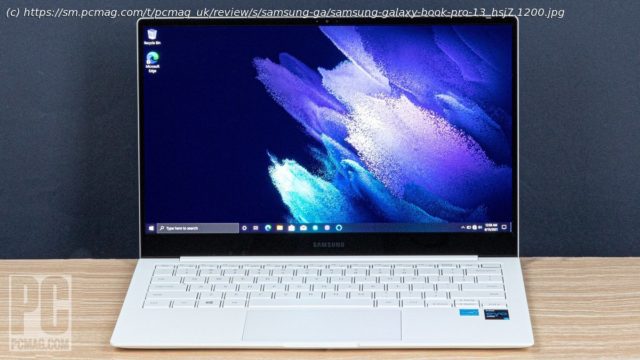This airy OLED ultraportable is admirable—but not configurable
We’re always happy to see an elegant ultraportable laptop for under $1,000, especially if it has convenient HDMI and USB Type-A ports as well as USB-C/Thunderbolt ports, unlike the class-leading Dell XPS 13. The 13.3-inch Samsung Galaxy Book Pro ($974.99 as tested) not only checks those boxes but boasts a spiffy AMOLED screen like those of Samsung’s smartphones, all in a feather-light 1.96-pound package. So why doesn’t this review bear our Editors‘ Choice award insignia? Because the Galaxy Book Pro base model is also the maxed-out model, with 8GB of memory and a 256GB solid-state drive when multitaskers look for double those amounts, especially in this price range. It’s a sleek, tempting choice for everyday Microsoft Office and online work, but power users will want something more configurable. Two Sizes, Two Windows The Galaxy Book Pro clamshell model (distinguished from the regular Galaxy Book by its AMOLED versus IPS screen technology) is available in 13.3-inch and 15.6-inch display sizes, both with the familiar full HD (1,920-by-1,080-pixel) resolution and 16:9 aspect ratio instead of the taller 16:10 or 3:2 ratios that have become popular of late. Samsung doesn’t offer a higher-resolution panel, nor a touch-screen option. Our Windows 10 Pro test unit (model NP930XDB-KH1US) is listed among Samsung’s business products for $1,099.99 on sale for $974.99; an otherwise identical consumer model has Windows 11 Home for $999.99. Clad in an aluminum-magnesium alloy the company calls Mystic Silver (with a white keyboard deck), the Intel Evo -compliant laptop combines its 8GB of RAM and 256GB SSD with a quad-core,2.4GHz Core i5-1135G7 processor. Wi-Fi 6E and Bluetooth are standard, as is a fingerprint reader integrated with the power button (which you may not use much, since opening the lid turns the system on). Thirteen-inch ultraportables are all roughly the same footprint-size, though the Samsung is one of the trimmest and lightest at 0.44 by 12 by 7.9 inches and 1.96 pounds. The Dell XPS 13 OLED is 0.58 by 11.6 by 7.8 inches and the 2.2-pound HP Pavilion Aero is 0.67 by 11.7 by 8.2 inches. The Galaxy Book Pro’s light weight is reflected in its considerable flex if you grasp the screen corners or press the keyboard deck. Its screen bezels are thin but the webcam at top center has no privacy shutter. Laptops don’t come any thinner than the Samsung, at least not with real ports. An HDMI video output joins two USB Type-C ports, one with Thunderbolt 4 capability, on the left side. One USB 3.2 Type-A port, a microSD card slot, and a headphone jack are on the right. The compact AC adapter has a USB-C connector. Not the Brightest, But the Best-Looking The 1080p AMOLED display provides inky blacks and washday-white backgrounds, with phenomenal contrast. (Samsung rates its contrast ratio at 1,000,000:1.) The latter helps the display seem extra-bright, though in reality it didn’t excel in our hardware brightness measurement (see the test results below). Colors are rich, vivid, and well saturated, and fine details are clear. Reflections come into play at extreme viewing angles. Bottom-mounted speakers produce somewhat soft, muffled sound; bass is scanty (drumbeats sound like static), and it’s hard to hear overlapping tracks.






